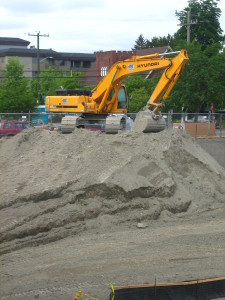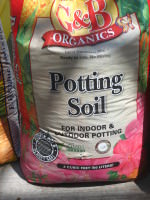Basics of Container Garden Design: Importance of Soil in Container Gardens
Choosing the Right Potting Soil for Planting Containers
One of the great benefits of container gardens is that they are
perhaps the most ‘controll able’ elements
of gardening. After all, we can choose their shape, exposure, contents and soil. We can even
move them around after they are fully planted (if we have help and perhaps some rolling
carts). When given so much control over a container planting, choosing a good potting soil
should be one of your primary concerns. Remember that old movie when Dracula said ‘The
blood is the life?’ With any container planting, choosing the right potting soil is
the life. We cannot overstate the importance of soil in container design. Every container
designer I know has their favorite soil. You will need to experiment to find the one you
like best, while keeping the following points in mind.
able’ elements
of gardening. After all, we can choose their shape, exposure, contents and soil. We can even
move them around after they are fully planted (if we have help and perhaps some rolling
carts). When given so much control over a container planting, choosing a good potting soil
should be one of your primary concerns. Remember that old movie when Dracula said ‘The
blood is the life?’ With any container planting, choosing the right potting soil is
the life. We cannot overstate the importance of soil in container design. Every container
designer I know has their favorite soil. You will need to experiment to find the one you
like best, while keeping the following points in mind.
Container Garden Design: Make sure your potting soil is free draining. A good nursery should be willing to show you some of the soils they sell and let you handle them. They may even have a display rack showing open examples of the potting soils they sell. The potting soil you choose should not be too woody and should have plenty of ‘white bits’ (perlite or vermiculite) in it. You won’t know which of these it is, although many manufacturers have abandoned vermiculite because of its asbestos link. It is always a good idea to wear a dust mask when working with dry potting soil.
Container Garden Design: Why not use bagged ‘topsoil’ or regular soil from your garden?
The soil in our gardens is spread over a large area.  This in itself increases the drainage.
However, in a container planting there is not enough area to create the same speed of
drainage, so you run a great risk of creating a waterlogged container. The same is true of
bagged topsoil. In addition, you may transfer disease pathogens from your garden into your
container. Good quality bagged potting soil is sterilized. It may even be labeled “sterile
potting medium.”
This in itself increases the drainage.
However, in a container planting there is not enough area to create the same speed of
drainage, so you run a great risk of creating a waterlogged container. The same is true of
bagged topsoil. In addition, you may transfer disease pathogens from your garden into your
container. Good quality bagged potting soil is sterilized. It may even be labeled “sterile
potting medium.”
Container Garden Design: Why not use mulch?
Mulch used as a planting medium will pack down solidly and does not drain well in a container, quickly suffocating your plants. If you want to add mulch to your container planting, add no more than one-quarter of the overall volume of soil and mix well. However, it is a great idea to lightly top mulch your container planting when it is complete in order to retain moisture and keep your lovely pots from drying out so quickly in the heat. Only apply about an inch of mulch then rinse and water both planting and pot.
You can re-use potting soil if you want to go to the trouble of shaking all the root mass from it first. If there isn’t a lot of root mass in the pot you can just remove the top eight inches or so of old potting soil, chop up as much of the remaining soil as you can, and add fresh potting soil. If you are adding plants to the existing arrangement, be very careful not to damage a lot of their roots. If the container is to be emptied of all plants, then chopping up the old soil is a relatively easy task. For my clients, I will change out all the soil if it is very ‘rooty.’ Clients do not pay me to clean soil and it is often faster and more cost effective to change out all the soil.
Can you make your own potting soil?
You certainly can make your own potting soil, and if you have the time and space to do that there are many good recipes out there. A great many wholesale nurseries make their own potting soil, of course, since they are potting up thousands of plants at a time. As a professional container garden designer/installer, I choose the most organic, free-draining, cost-effective option open to me in a bagged potting soil because the cost of making my own is prohibitive.
Should you add gravel to the bottom of your container to increase the drainage?
No, no, a thousand times no! This  garden myth was discredited years ago. It
adds nothing to the drainage and may even create a perched water table. The roots of your
plants need all the soil available to them in a container. In addition, don’t add
polystyrene pellets to the soil. Just fill the container with soil from top to bottom. It’s
the best thing for the plants, and it’s the best thing for creating a beautiful patio
pot, deck planting or any other type of container garden.
garden myth was discredited years ago. It
adds nothing to the drainage and may even create a perched water table. The roots of your
plants need all the soil available to them in a container. In addition, don’t add
polystyrene pellets to the soil. Just fill the container with soil from top to bottom. It’s
the best thing for the plants, and it’s the best thing for creating a beautiful patio
pot, deck planting or any other type of container garden.

